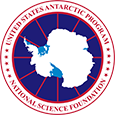 Researchers Use Ice-Penetrating Radar to Better Understand Antarctic GlaciologyJuly 1, 2021
A recent publication from NSF-funded research by scientists at UC Santa Cruz has examined how electrical conductivity, and not radar reflectivity alone, should be used in investigating subglacial materials. The work uses surveying in Antarctica, combined with a literature review, to suggest that a range of geologic materials can have electrical conductivity that is high enough to significantly impact the value of radar reflectivity. Additionally, the work shows how including electrical conductivity in the calculation of the radar bed reflectivity may explain results that may be considered surprising in situations where the data are not incorporated. Read the full article at https://tc.copernicus.org/articles/14/4495/2020/tc-14-4495-2020.html. Images: NSF/Dan Frerich
|



For USAP Participants |
For The Public |
For Researchers and EducatorsContact UsU.S. National Science FoundationOffice of Polar Programs Geosciences Directorate 2415 Eisenhower Avenue, Suite W7100 Alexandria, VA 22314 Sign up for the NSF Office of Polar Programs newsletter and events. Feedback Form |
